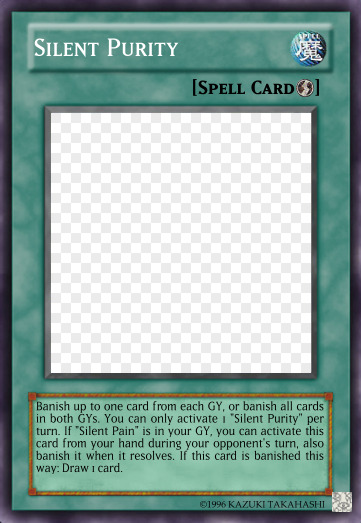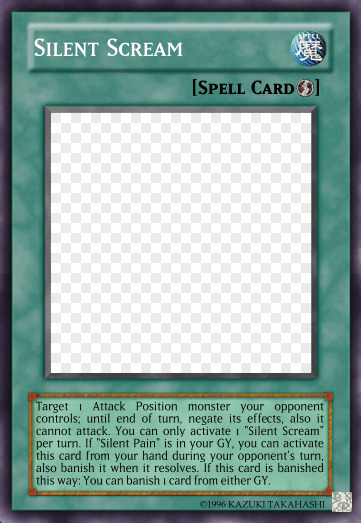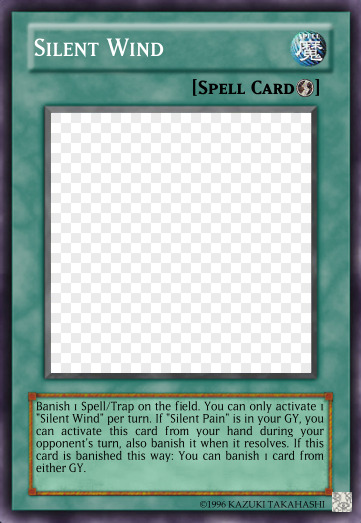#and link monsters start in the extra deck and are summoned by sacrificing the listed material
Photo

I’m something of a criminal myself
-
It’s okay committing internet crimes is cool and fun. In other news here’s some yugioh cards based off of some really bad anime cards.










#asks#custom cards#uh oh this batch has pendulums and links#they're weird#basically pendulums can be played as regular monsters or as continuous spells#and they have a really weird gimmick where instead of going to the graveyard they go to the extra deck because reasons#and link monsters start in the extra deck and are summoned by sacrificing the listed material#there's other weird stuff about them but it's not important#just a weird gimmick deck that doesn't fight with monsters#it just stalls and destroys and burns#probably not very fun lol#but i wanted to do the anime's concept justice#is it good?#no#but that's probably for the best#in other other news i tried to find a better rhythm game to make pmd levels for#i failed#somehow all the other rhythm games have bad editors#or massive lag in the case of osu#i wanted something simpler because fnf has a ton of extra features that i'm not using#so i figured there's probably a simpler game of the same style#and there are#but the editors are trash#somehow a fan-made fnf mod is better than official editors in other games
4 notes
·
View notes
Text
Yu-Gi-Oh! Summoning Methods, Ranked from Worst to Best
The game of Yu-Gi-Oh!, much like the ongoing anime franchise, has gone through several changes since its humble beginnings as “Monsters and Wizards.” With a legacy that spans more than 24 years, every new series and expansion brought new mechanics and more strategy to every duel. Of course, I’m talking about the various summoning methods available to players.
The rules for putting monsters out on the field have gotten much more complex than just slapping a card down in your Monster Zone or tributing your weaker monsters for stronger ones. There are six methods you can use. From mashing together your cards with Fusion to stringing them with each other using Link, the amount of monsters you can get on a single turn can really turn the tide of the game.
But not all mechanics are as good as others. Some summoning techniques can be pretty intuitive, while others are clunky and can disrupt the flow of a deck if you’re not careful with building. I’m not a professional Yu-Gi-Oh! player by any stretch, but I enjoy and appreciate the game enough to have my own understanding of which methods work and which don’t.
To that end, here’s my list of Yu-Gi-Oh! summoning methods, starting from the worst and working my way up to what I consider the best.
The Worst: Ritual
Let’s start with the bottom of the barrel. Introduced in the game’s early days as well as episode 30 of the original Duel Monsters anime, Ritual summoning requires a number of cards in your hand or on the field. Namely, you need a specific Ritual card, the Ritual monster it summons, and the required amount of monsters to fulfill the summon. These monsters generally have higher attack points and/or special effects.
Ritual summoning is easily one of the clunkiest mechanics in the game, and it’s honestly surprising that it hasn’t been phased out yet. Unlike other methods, Ritual summons do not take advantage of the Extra Deck; the place where Fusions, Links, and other special monsters are generally placed during gameplay so they don’t clutter up your main deck. Under the right conditions, you’d be able to summon your special monsters right from there so they don’t collect dust in your hand while you fish for the right Chain.
This isn’t the case with Rituals. Every component must be in your hand or on the field for you to be able to use Ritual summon. Furthermore, you’d need one very specific Ritual Spell to summon its very specific corresponding monster. Barring any cards that let you search your deck, that’s too much effort for what amounts to Tribute Summoning with extra steps and meager results.
Throughout the years, the game has consistently tried to adjust the cost benefits for Ritual Summoning. Certain Ritual monsters and effects even have substantial impact on other summoning methods. But despite the growing possibilities, this archaic gameplay element hasn’t seen nearly as much care and attention as it needs to make it more viable in actual duels. With the sheer amount of trouble you’d have to go through to get out a Ritual monster, its place as the worst of the summoning methods is a no-brainer.
A decent step-up: Synchro
Introduced with Yu-Gi-Oh 5D's, Synchro summoning takes advantage of the exact Levels (number of stars) of monsters, and introduces cards with white backgrounds. A player must have a Tuner monster (specified in the card’s description) and a variable number of non-Tuners to summon a Synchro monster. The individual Levels of the cards being sacrificed must match the level of the Synchro monster you’re trying to pull out.
It’s certainly a step up from Rituals, wherein the only requirements for a Synchro monster are the appropriate amount of Levels. You don’t need an extra magic card; so as long as you can get your Tuners and monsters out, you’re good. But Tuners themselves can be a bit tedious to work with when it comes to the exact math.
By and large, Tuners are simply fodder to summon bigger monsters and don’t serve much purpose outside of that. By themselves, they tend to be low-level with low stats that wouldn’t be much help during a Battle Phase. Not to mention you’ll need enough regular monsters with the right Levels. If you’re constructing your deck with Synchro in mind, it’s generally a good idea to be able to use your Tuners for Synchro Summoning right away. Certain cards will even allow you to adjust your monsters’ Levels to suit your needs. Otherwise, it’s rather frustrating to run too many Synchros in your deck while having to keep everyone’s Levels in mind.
Evolving with the game: Fusion
This particular method was also introduced in the original series, but received a far bigger spotlight in Yu-Gi-Oh GX. The most basic way one would Fusion Summon would be to have a “Polymerization” card to “merge” the materials in your hand or on the field and get your new Fusion Monster from the Extra Deck.
Despite its similarities to Ritual summoning, Fusion is a little looser in terms of execution. Polymerization can be used for any Fusion Monster at your disposal, so you can use them without much fuss. There are also other cards such as “Super Polymerization” and “Future Fusion” that offer the same Fusion opportunities in different situations.
One of its major drawbacks, however, is that the recipe for a Fusion monster can be strict. Many of them boil down to using specifically-named monsters listed on the Fusion’s requirements, so you’d still have to dig a considerable amount to pull out the necessary components. Recent Fusion monsters are far more lenient with their recipes, asking for monster types and elements as opposed to explicitly naming individual cards. While it’s still not the most intuitive, it’s at least seen updates over the years, so that counts for something.
The latest and okay-est: Link
As of writing, this is the most recent addition to the Yu-Gi-Oh meta (barring Rush Duels being phased in with the upcoming Yu-Gi-Oh Sevens series). Featured heavily in Yu-Gi-Oh Vrains, Link monsters are called out to the “Extra Monster Zone,” a new zone that delegates all Extra Deck monsters toward that one spot. Once you fulfill the summoning conditions on the card (a certain amount of certain types of monsters), you can get a Link Monster out. Using the arrows on the cards, you can also string your monsters together across the field for different effects and advantages.
With only one Link monster, it’s easy to get the ball rolling with even more Link summoning. True to its name, Link monsters work in conjunction to call each other out and increase your capabilities. Given enough resources, you can call upon a vast array of Link monsters in one turn and have them effectively work together to achieve victory.
Its initial integration, however, was not the most seamless. When it was first implemented back in 2017, it added that Extra Monster Zone for you to have six monsters, at least. But there were a number of enormous catches that altered the initial landscape of the game.
While other summoning methods were gently phased into Yu-Gi-Oh without disrupting its original flow, everything had to be adjusted to accommodate Links. Barring any advantages from Link Summoning, you could only have one Extra Deck monster out on the field at a time, so it severely limited any builds with a focus on Synchro or Fusion and made Links almost mandatory by nature. Placement of monsters in certain zones also suddenly became an essential element when it had virtually no bearing previously. The upcoming “Master Rules” update looks to run back some of the more questionable summoning restrictions on Extra Deck monsters. But for a while, the inclusion of Link monsters seemed to monopolize every other aspect of the game as a misguided counterbalance to the advantages you could get from it.
Link Summoning does yield some great results and fun combos by chaining monsters together. It provided a much-needed nerf to a method I’ll be talking about later, but it also impacted the rest of the meta almost as an unintended consequence. As of April, it will no longer do that, and will finally be integrated more smoothly into the game. Those patches to Links most certainly help its position in the top three on this list.
The runner-up: Xyz
In terms of practicality, ease of use, and overall usefulness, Yu-Gi-Oh Zexal's Xyz Summoning (pronounced ex-ease) is probably one of the most intuitive.
In order to Xyz summon, one must have at least two monsters of the same Level, and stack them on top of each other to put an Xyz monster (monster cards with black backgrounds who have Ranks instead of Levels) from your Extra Deck on top. Once you do that, you can come up with clever combinations and effects by discarding one of the materials stacked under your Xyz monster and unleashing them as necessary.
Xyz can be very flexible with any deck, yet also lets you reap tons of rewards. An Xyz-focused deck will normally help you get a few monsters out at once so you can Xyz summon right away to get things started. Using mechanics like “Rank-Up Magic” also allows you to get more powerful Xyz monsters out without having to worry too much about the Levels of your regular monsters. And being able to use their effects multiple times at once is kind of like having a monster with ammo that you can unload.
But even if you’re not exclusively running Xyz in your deck, you can always find some room in your build for them. Some Xyz cards might ask for a certain number of monsters or specific types as part of the materials, but the Levels are usually the most important requirement. Otherwise, it’s easy enough to have monsters with the same level in any deck. If you can find the right Xyz monsters with the appropriate Levels and requirements, you can basically slide them in for some extra firepower without disrupting the initial build you have going.
Xyz summoning is flexible, easy to grasp, and can be truly effective in any duel. You can certainly find room for it in your Yu-Gi-Oh play, and it’s going to sit quite comfortably as the second best summoning method on my list.
The best: Pendulum
When you need multiple monsters out at once for fancier summoning techniques, it can be difficult getting your side of the field in order when you’re limited to one regular summon at a time. Under normal conditions, it’s not always easy to run a deck that lets you call out as much as you need on a given turn. But whether you’re using Xyz or Synchro or just need to have enough monsters to do something, Pendulum Summoning has got you covered. I might be a bit biased because I run Pendulums in my casual play, but the mechanic introduced alongside Yu-Gi-Oh Arc-V can be incredibly rewarding, so it earns top billing in my book.
Pendulum Summoning phased in new cards that acted as either monsters or spells depending on how you used them. By setting up two Pendulum cards in your “scale,” you could summon multiple monsters at once depending on their Levels. For example, if you set Pendulum cards for a scale from 1 to 8, you can summon as many monsters as possible that are Levels 2-7.
For a game that uses its monsters as a major resource for gameplay, Pendulum facilitates all summoning methods very well. Whereas normally, you might have trouble getting out enough fodder to break out the big guns, Pendulum summoning lets you strategically send out the monsters you need for more things.
Have a Tuner you want to use with a non-Tuner? Pendulum Summon both of them to get right to your Synchro. Want to Tribute Summon a stronger monster? Pendulum Summon two monsters to flow into your Tribute without having to wait an extra turn! Trying to build a wall against your opponent’s stronger cards? Bring out all the monsters in your hand at once. Pendulum Summoning is great for building up defenses or expanding your other summoning options all in one fell swoop. Even if you can't get the proper scales in order to summon, there are also plenty of support cards to help you adjust them to your liking.
When Pendulum was first introduced, it seemed incredibly easy to abuse. Given the right conditions, you could continually summon monsters from both your hand or the Extra Deck, so you could even be so dirty as to stall out with monsters until you drew the cards you needed. As of 2017, the Master Rules delegated Pendulum summons from the Extra Deck to one at a time via the Extra Monster Zone, which is a pretty reasonable trade-off.
But the potential that one can muster using Pendulums and the fun I’ve had with it thus far make for one of my favorite summoning methods in the game. Even now, it's a fun and innovative mechanic that not only stands out on its own, but helps support all the others.
Yu-Gi-Oh! continues to evolve even to this day. Monsters have gotten stronger and there are only too many ways to summon them. With so many techniques and strategies at your disposal, it’s easy to create unique styles of play and carve out your own path to being a duelist!
Which is your favorite summoning method? How would you rank your preferences? Let us know in the comments!
----
Carlos is a freelance features writer for Crunchyroll. Their favorite genres range from magical girls to over-the-top robot action, yet their favorite characters are always the obscure ones. Check out some of their satirical work on The Hard Times.
Do you love writing? Do you love anime? If you have an idea for a features story, pitch it to Crunchyroll Features!
0 notes